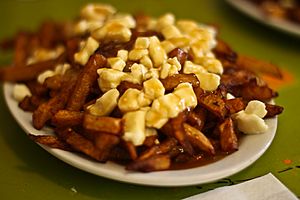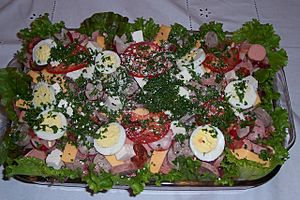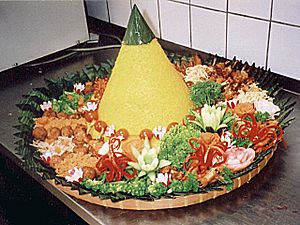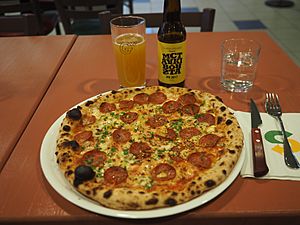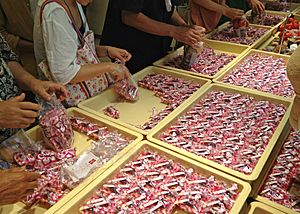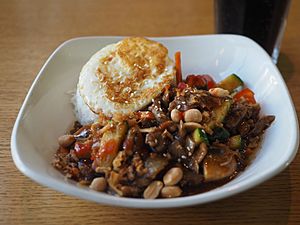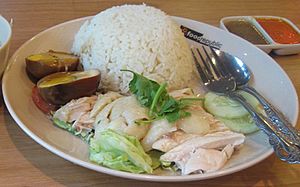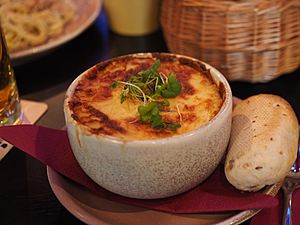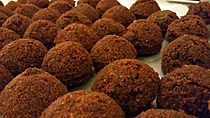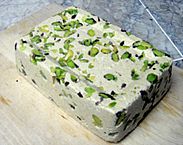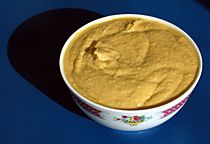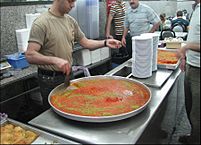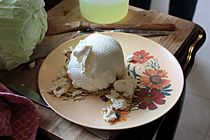Traditional food facts for kids
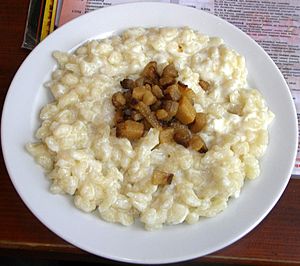
Traditional foods are dishes and drinks that have been enjoyed for many years. They are passed down from parents to children, often for hundreds of years! These foods are a big part of a country's, region's, or even a local community's tradition.
You can find traditional foods made at home, in small restaurants, or even in large factories. Some traditional foods in Europe have special labels. These labels, like PDO or PGI, help protect the food's name and show that it's made in a special way in a certain place. This article also talks about traditional drinks.
Contents
- What's the Difference Between Traditional and Typical Foods?
- Traditional Foods Around the World
- Traditional Foods by Country
- Canada
- China
- Costa Rica
- Croatia
- Cyprus
- Czech Republic
- Estonia
- Eswatini
- Faroe Islands
- Finland
- France
- Germany
- Guatemala
- Iceland
- India
- Indonesia
- Iran
- Ireland
- Italy
- Japan
- Jordan
- Korea
- Latvia
- Lithuania
- Maldives
- Malta
- Mexico
- Nepal
- Portugal
- Saudi Arabia
- Singapore
- Slovakia
- Spain
- Sweden
- Switzerland
- Tanzania
- Thailand
- Turkey
- Uganda
- United Kingdom
- United States
- Vanuatu
- Yemen
- Traditional Foods by Region
- See also
What's the Difference Between Traditional and Typical Foods?
Even though "traditional" and "typical" foods sound similar, they mean different things. People who study food history say they are not the same.
What is Traditional Food?
Traditional food means cooking customs that are passed down by talking, not written down. This happens in families and in whole communities. It's a big part of their culture and who they are.
What is Typical Food?
Typical food is what most people in a place like to eat. It's made a lot and is very popular. So, a traditional dish can be typical, and a typical dish can be traditional. But not all typical dishes are traditional, and not all traditional dishes are typical.
Most traditional dishes started with clever cooks at home. They used what they had to create new recipes. If people liked a recipe, it was copied and shared. This is how a recipe becomes a classic. Traditional cooking has many classic recipes. These recipes are linked to a specific place, its local foods, and its habits. Some classic recipes might be forgotten. But if they are eaten a lot, they become part of a place's typical food.
Food Made for Money
Sometimes, food is made mainly to earn money. This is called "commercialized cuisine." These foods might use the word "traditional" but don't care about the food's real history. They just want to sell it. People often buy these foods thinking they are truly traditional. This can make people forget the many different ways food was made in the past.
Traditional Foods Around the World
Traditional foods are found everywhere! They show the history and culture of different places.
Africa
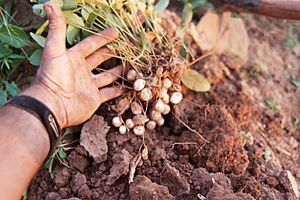
- Bambara groundnut – a plant grown for food in Africa.
Europe
Traditional foods are a very important part of European culture. They show the identity and history of different regions.
South America
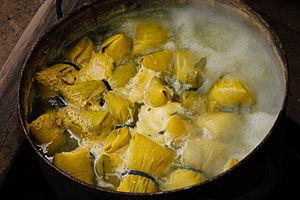
- Humita – a traditional food in Bolivia, Chile, Ecuador, and Peru.
Traditional Foods by Country
Canada
- Country food – These are the traditional foods of Aboriginal people in Canada. This includes First Nations, Metis, and Inuit. In northern areas, these foods are still very important because other foods are expensive.
- Thanksgiving dinner
Québec
- Poutine
- Tourtière
- Sucre à la crème
- Pâté chinois
- Pouding chômeur
- St. Catherine's taffy
- Spruce beer
- Maple syrup
- Cretons
Acadia
China
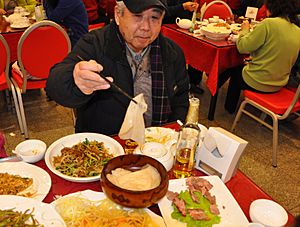
- Ciba cake
- Dim sum
- Fuling jiabing – a traditional snack from Beijing. It's a pancake made with flour, sugar, and a special mushroom. It's rolled around nuts and honey.
- Spring pancake – a traditional Chinese food from northern China. People eat these pancakes on a day called lichun to celebrate the start of spring.
- Zhongzi – sticky rice with tasty or sweet fillings. It's wrapped in bamboo leaves and boiled. People make it for the Dragon Boat Festival.
Costa Rica
Croatia
Cyprus
- Tsamarella – a traditional food and a main lunch meat in Cyprus.
Czech Republic
Estonia
- Mulgipuder
- Sepik
Eswatini
- See cuisine of Eswatini#Traditional foods for more.
Faroe Islands
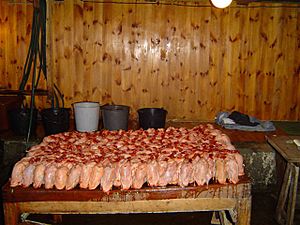
- Faroese puffin
- Garnatálg
- Skerpikjøt
- Whale meat
Finland
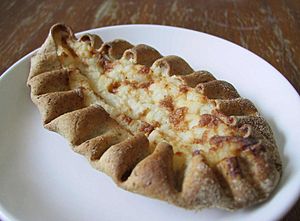
- Karelian stew
- Karelian pasty
- Kesäkeitto
- Sautéed reindeer
- Ruisreikäleipä
- Ryynimakkara
- Mustamakkara
- Kalakukko
- Lörtsy
- Rönttönen
- Sultsina
- Mämmi
France
- Appellation d'origine contrôlée – a French label for special wines, cheeses, and other farm products. It shows where they come from and how they are made.
- Bresse chicken – a special chicken with this label.
Germany
- Black Forest ham – made in the Black Forest region. It has a special European Union label.
Guatemala
- Fiambre is a traditional Guatemalan dish. It's made and eaten every year for Day of the Dead and All Saints' Day.
Iceland
- Hákarl – a traditional food and the national dish of Iceland.
- Hangikjöt
- Þorramatur – a mix of traditional Icelandic food. It's mostly meat and fish that are preserved in old ways. It's served with dark rye bread, butter, and a drink called brennivín.
India
Indonesia
- Brem – a fermented snack and drink from Java and Bali.
- Docang – a traditional food from Cirebon.
- Gado-gado – a traditional salad with peanut sauce.
- Gudeg – a stew made from young jackfruit. It's a traditional food from Yogyakarta.
- Ketupat – a traditional rice dumpling. It's often eaten during Lebaran, a big holiday in Indonesia.
- Kuluban – an old Javanese traditional salad.
- Lawar – a traditional Balinese vegetable dish.
- Opor ayam – Chicken in coconut milk stew. It's often eaten with ketupat during Lebaran.
- Pallubasa – a traditional food from Makassar. It's made from parts of cattle or buffalo.
- Papeda – sago porridge. It's a main food in Eastern Indonesia.
- Rendang – a traditional dish from West Sumatra.
- Satay – grilled meat on sticks. There are many traditional kinds in Indonesia.
- Soto – a type of traditional Indonesian soup. Many different kinds exist.
- Tempeh – fermented soy cake. It's a traditional food from Java.
- Tumpeng – a special rice cone with many side dishes. It's an Indonesian national dish.
Iran
- Chelow kabab
- Tahdig
- Ghormeh sabzi
- Fesenjān
- Sabzi polo
- Abgoosht
- Gheimeh
- Sholezard
- Āsh
- Mirza Ghassemi
- Nargesi
- Baghala ghatogh
Ireland
Italy
- Pasta
- Pizza
- Prosciutto (PDO)
- Ravioli
- Salami
Piedmont
- Panna cotta – This dessert is listed as a traditional food in the Piedmont region of Italy.
Japan
- Mochi – a traditional food for the Japanese New Year. It's eaten all year in Japan.
Jordan
Traditional drinks in Jordan include sous (made from Liquorice), tamr hindi (made from Tamarind), and laban (made from yogurt and water).
Korea
Latvia
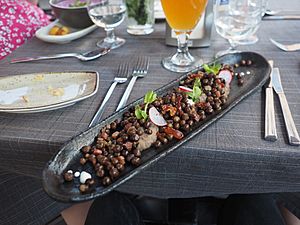
Lithuania
Maldives
- Garudiya
- Maldive fish – dried tuna fish made in the Maldives. It's a main food in Maldivian cuisine.
Malta
- Kwareżimal – a cake eaten during Lent.
Mexico
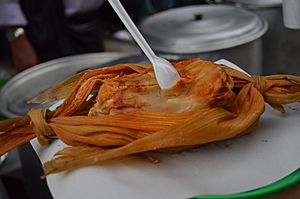
- Atole
- Capirotada – often eaten during the Lent season.
- Chiles
- Enchilada
- Iguana meat
- Legumes, beans and refried beans
- Maize
- Mole sauce
- Pork
- Rice – usually fried until golden before cooking.
- Rice and beans
- Sope
- Tamale
Nepal
Portugal
- Denominação de Origem Controlada is a system that protects the origin of wines, cheeses, and other farm products from Portugal.
Saudi Arabia
- Hininy
- Kabsa
Singapore
- Hainanese chicken rice – thought of as a national dish of Singapore.
- Teochew porridge
Slovakia
- Bryndzové halušky – a national dish of Slovakia. It's made of halušky (dumplings) and a special cheese called bryndza.
- Lecsó
Spain
- Boroña – a cornbread that is a traditional food in parts of Spain like Galicia and Asturias.
- Denominación de Origen – a system for classifying Spanish wines and other foods like cheeses and meats.
Sweden
Switzerland
- Appellation d'origine protégée – a Swiss label that protects the origin and quality of traditional foods (not wines).
- Capuns – a traditional food from the Graubünden area in Switzerland.
Tanzania
- See Pare people#Traditional food for more.
Thailand
Turkey
Uganda
- Malewa – smoked bamboo shoots that are dried to keep them fresh. This food comes from Eastern Uganda.
United Kingdom
England
Wales
Scotland
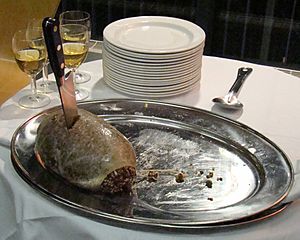
United States
- Cardamom bread – a traditional food for Swedish Americans.
- Thanksgiving dinner
Southern United States
- Biscuit
- Cheese straw
- Cornbread
- Collard greens
- Hoppin' John
- Sweet potato
Vanuatu
- Laplap – a national dish.
Yemen
Traditional Foods by Region
Arab states of the Persian Gulf
- Khabees – a traditional sweet dish in the Arab states of the Persian Gulf.
Commonwealth Caribbean
- Rice and peas – a traditional dish in the Caribbean islands.
Levant (Eastern Mediterranean)
Traditional foods in the Levant include falafel, fuul, halawa, hummus, kanafeh, labaneh, medammis, and tahini. The most popular traditional foods here are made from legumes, like falafel, fuul, hummus, and medammis.
- Popular traditional foods in the Eastern Mediterranean region
Southern Africa
- Soured milk – a traditional food of the Bantu peoples in Southern Africa.
See also
 In Spanish: Gastronomía tradicional para niños
In Spanish: Gastronomía tradicional para niños


